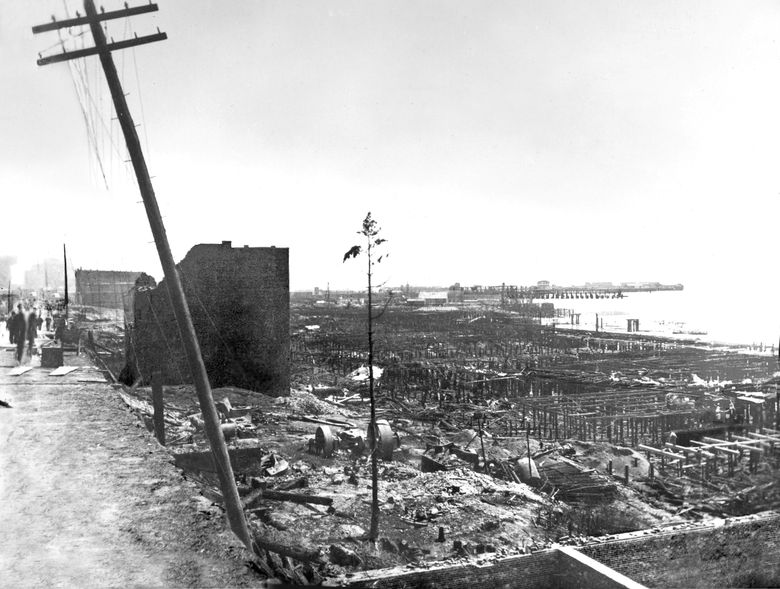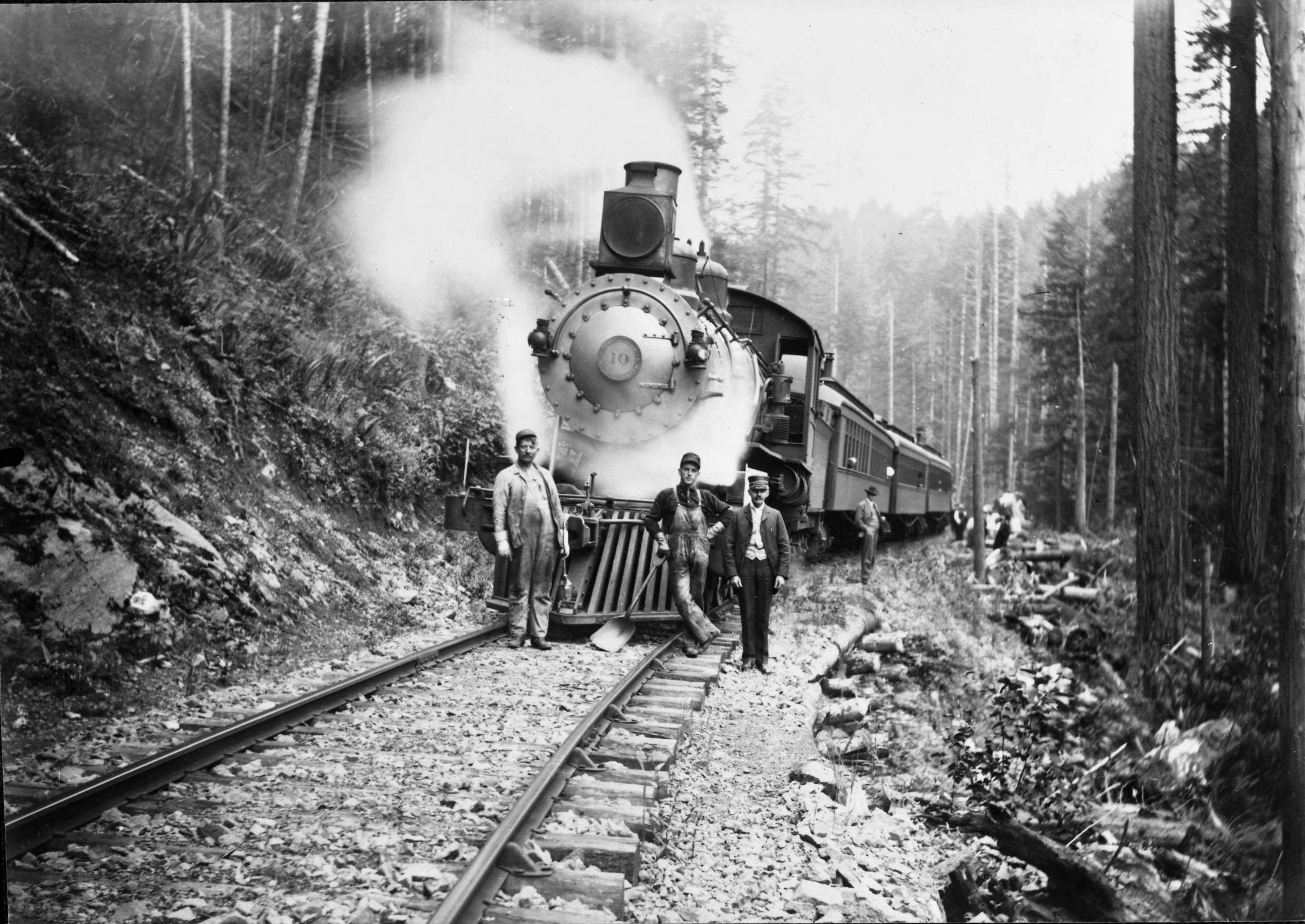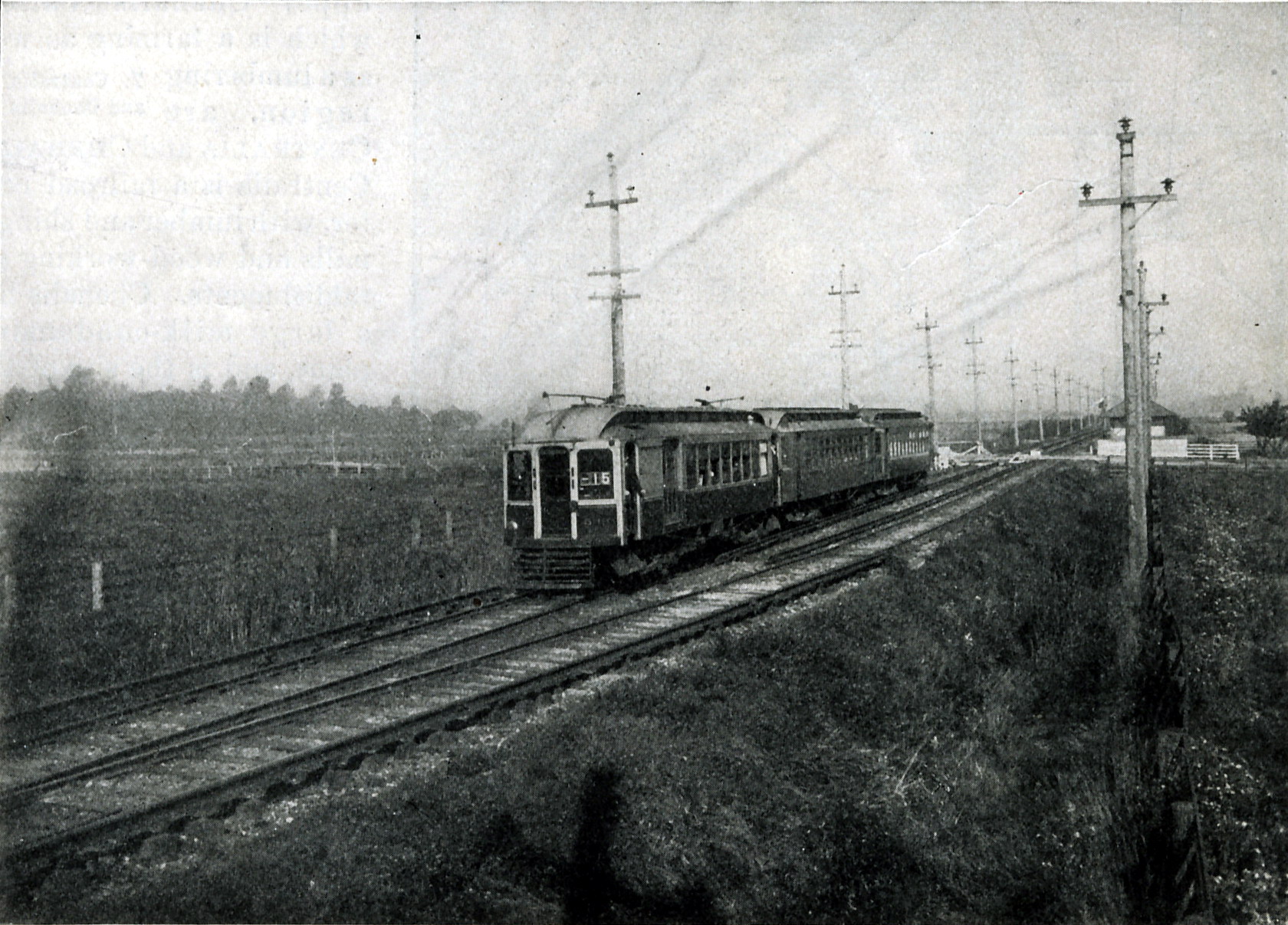-----
 |
| A Northern Pacific train rolls through what would eventually become Yellowstone National Park, early 1900s (Big Sky Journal) |
We start on the day of September 25, 1902, when the first high-speed electric interurban in the Pacific Northwest opened between the port cities of Tacoma and Seattle, Washington State. Though the East Side Railway between Portland and Oregon City opened in 1893, the Seattle-Tacoma Interurban was held to main-line standards, and as such had the infrastructure and cars to achieve main-line speeds. But getting to this mark took a lot of effort, stormy washouts, death, and most of all: real estate.
 |
| The first locomotive arrives in Puget Sound, 1871 (HistoryLink.org) |
 |
| Devastation left behind from the 1889 Seattle Fire (The Seattle Times) |
However, the railroad was not met with open arms, especially in the White River Valley lying between Tacoma and Seattle. The Northern Pacific had carte blanche on operations as they displaced traditional horse-and-wagons on muddy roads, which left many passengers and supplies unable to keep up with the new higher fares and freight rates. The giant Seattle fire of 1889 and the Panic of 1893 left city officials looking for alternatives.
That alternative came in 1900, when Fred E. Sander became involved in Seattle-area real estate and railroad promotion. His first operations, the Yesler-Jackson Cable railway and the Grant Street narrow gauge streetcar, brought him such success that the city gave him a franchise for an interurban railway to Tacoma via the White River Valley. A consortium of incorporated individuals, including Sander himself, was formed to fully flesh out the interurban route, which involved double-tracking and regauging the Grant Street line to standard.
/cdn.vox-cdn.com/uploads/chorus_image/image/56738081/capitol_hill_streetcar.0.jpg) |
| A Seattle Electric streetcar prior to the 1900s (Curbed Seattle) |
Sander traveled east to New York to secure capital and by February 1901, one million dollars of new funds was directed towards development. The Puyallup Indian Reservation and US Department of Interior were also contacted, as construction would go right through their land, stretching 33 miles to Tacoma. Sander's original intent was to extend the Grant Street line all the way to Tacoma, but Seattle Electric, a rival company, bought the franchise when it went into recievership.
Seattle Electric had earlier planned a route in competition with Sander's line to Tacoma, but now that they had Sander's line, he was immediately out of the picture. A prominent seattle banker named Jacob Furth proclaimed to the White Valley that the interurban would be "operational by January 1902", with a "first class, thirty minute service between [Seattle and Tacoma]" (Wing, 12). Needless to say, the whole Valley was thrilled, especially after the Interior Department approved the Right-of-Way through the Puyallup Reservation.
 |
| An early NP passenger train service between Seattle and Tacoma, 1908 (Tacoma Public Library) |
As construction began in mid-May 1901, some people had reservations about the rapid transit displacing steam and steamboat lines. The railroads, "in high-minded style", proclaimed in newspapers that "They will go on just the same," (Wing, 13) which just about left everyone relieved. In the meantime, as the line stretched down to Stewart's Point, steam locomotives were running on the new interurban to test the track by October of 1901. This stirred up more anxiety in the population, fearing Northern Pacific was trying to gain another route to Seattle through them.
While electric poles went up into late 1901 and 1902, with a running voltage of 500V DC with three substations driving both wire and third-rail, death also struck construction management and momentarily halted all work. John Hale forced a total halt in January as he was losing money, but after being reimbursed by the bonding company, he died just as he got back to work in March of typhoid fever. Stone & Webster of Boston, the new holders of the Seattle Electric interurban, as well as the streetcars in Seattle and Tacoma by 1901, got through to the bonding company and construction resumed shortly after.
August 1902 saw the testing of the new third-rail system using one of the new Brill Interurban cars, No. 500. The test went off a success from Van Asselt Station to Riverside (with return), with a trackspeed of 55 mph held, but unfortunately after the test, several crewmen were shocked so hard "as if struck by lightning" in Kent following an accidental power activation in Seattle. Two of the interurbans were also damaged during delivery and had to be sent back to Brill, but officials reported this would not delay the opening.
 |
| A 1914 view of an unknown-direction Seattle-Tacoma Interurban train (Public Domain) |
September 14 saw the inauguration of service from Seattle to Renton, not all the way but still a healthy demonstration of service with a 15-cent fare. That same day, company officials were taken on the full route to Tacoma and upon deeming the line satisfactory, the Seattle Electric made its first revenue run on the whole line on September 25, with the first service departing Tacoma at 6:15AM and departing Seattle at 6:50AM. Over a total of 22 stops along its 36 1/2 miles of track, the new service was a success (until it had to be cut back from 1st and Pike to 1st and Yesler due to the two-percent grade on 1st Street being too much.)
 |
| The new "Interurban Building" which housed the PSE Company (Paul Dorpat) |
Two big changes over the next two months occured in quick succession. On October 7th, an unladen test train set a speed record when it hit a maximum of seven miles in six minutes, with the stretch between Kent and Auburn hitting more than a mile a minute. The new interurbans also hit the passenger ships hard, with the faster service leaving the slower ferries in the dust (even with severe 75% cuts on passenger rates.)
The other big change occured on November 23rd, 1902, Thanksgiving Day, when the Seattle-Tacoma Electric Railway was incorporated as the Puget Sound Electric Railway (PSE). Its headquarters (and Tacoma terminus) were moved from Kent to Tacoma on Occidental Street and, as such, felt more at home in Tacoma than it did in Seattle. Once the initial novelty of the interurban had died down and passenger numbers shrank to normal operating levels, the PSE could now hunker down and establish itself as a lifeline of Puget Sound.
-----
Sorry if there was no update on Tuesday, but I was severely ill and it turns out writer's block is a symptom of a minor cold. We'll be back on track now with our regularly-scheduled service, and tomorrow will be another "From the Archives" posting! Until then, ride safe and enjoy our new month in the Evergreen State!

No comments:
Post a Comment